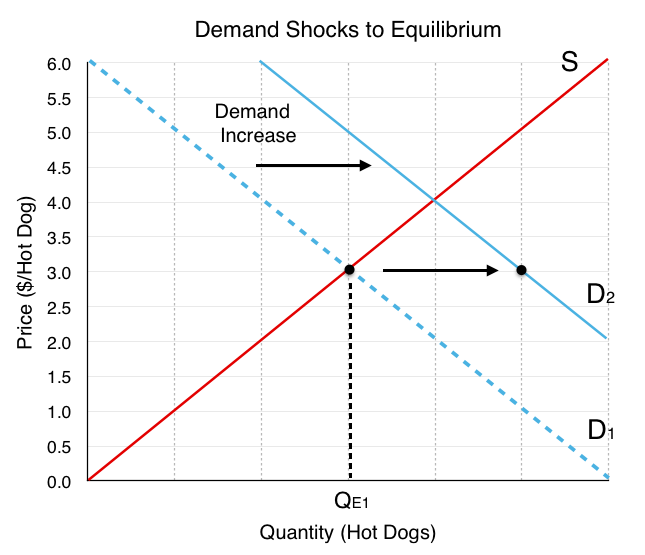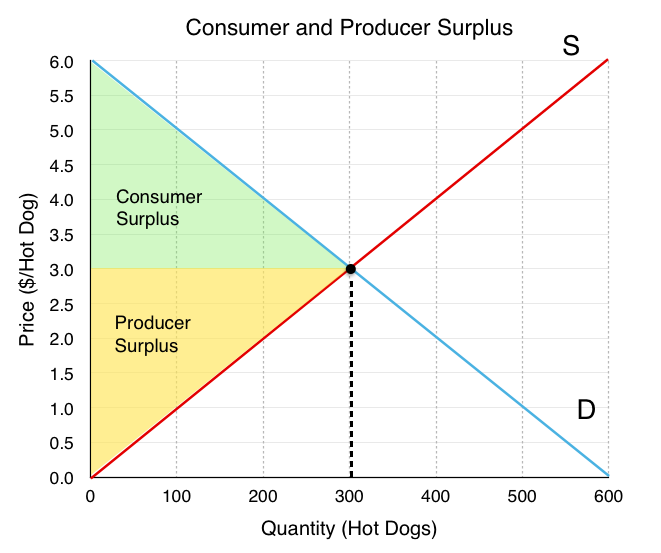At Equilibrium the Total Amount of the Product S
Therefore the equilibrium partial pressure of PCl5 is 229 atmospheres for PCl3 its 140 minus x 140 minus 033 is equal to 107. Total amount spent by buyers on the product.

3 6 Equilibrium And Market Surplus Principles Of Microeconomics
At equilibrium the total amount of the products a.

. At chemical equilibrium the amount of product and reactant is zero product and reactant remains constant product is zero because all molecules have the same activation energy an equal number of molecules take part in the reaction the rates of the forward and reverse reactions are equal 2. Is always greater than the total amount of the reactants. When a system reaches equilibrium the reaction stops.
School Valley Vista High School. At equilibrium in a market for a product the total revenues received by sellers equal the Multiple Choice market producer surplus. As r falls to r 1 the equilibrium gets disturbed and new equilibrium is found at y 1 bringing S T Ir 1 G and establishing equilibrium in the product market.
Total profit of sellers. May be equal to greater than. Is always greater than the total amount of the reactants.
Now that we know x is equal to 33 we can solve for the equilibrium partial pressures. Is always equal to the total amount of the reactants b. Is always greater than the total amount of the reactants.
Then the equilibrium shifts towards the direction where number of molecules are less ie. At equilibrium the total amount of the products - 2458379. Marginal Revenue - Marginal Cost MR-MC Approach.
2Beauty is a firm that offers cosmetics and beauty productsThe company introduces a new type of wet facial tissue paperTo familiarize target consumers with the product the company offers the. When a system reaches equilibrium the rates of the forward and reverse reactions are equal. If a reaction is carried out in the presence of a catalyst will the amount of product present at equilibrium increase decrease or stay the same.
Course Title MATH AB. So the total amount of C l 2 increases. When n 0.
When a market is in equilibrium the total amount of consumer surplus must be _ the total amount of producer surplus. And when you do all that math you find that x is equal to 330. Of molecules per unit volume increases.
Is always greater than the total amount of the reactants. At equilibrium the total amount of the products a. When a system reaches equilibrium there are more products present than reactants.
Is always equal to the total amount of the reactants. Since price OP is equal to average cost AC at this long-run equilibrium output with zero pure profits total value product PQ will be equal to the total cost TC. May be equal to greater than or less than the total amount of the reactants.
Correct answer to the question At equilibrium the total amount of the products a. When a system reaches equilibrium the concentrations of the products and reactants are equal. 5 The market demand for a product is made up of the demand from three firms X Y and Z.
As per Le Chateliers principles there will be no effect on Equilibrium and Product Formation on changing the volume pressure or inert gas. The total value product produced by the firm in this long-run equilibrium is equal to the area OPEQ. At equilibrium the total amount of the products o is always greater than the total amount of the reactan is always less than the total amount of the reactants is always equal to the total amount of the reactants may be equal to greater than or less than the total am.
Is always less than the total amount of the reactants. Is always equal to the total amount of the reactants. At equilibrium the total amount of the products a is always equal to the total.
Hence the output level at which the total revenue minus the total cost is maximum is the equilibrium level of the output. They may have an effect in gaseous reactions and that too only when the difference in the sum of the number of reactant and product molecules n is not zero. 196 plus 33 is equal to 229.
Total Revenue - Total Cost TR-TC Approach. Profit Total Revenue - Total Cost Which is written as P TR - TC. By decreasing the volume the no.
Is always greater than the total amount of the reactants. Is always greater than the total amount of the reactants. Is always less than the total amount of the reactants.
At equilibrium the total amount of the products a. At equilibrium the total amount of the products a is. May be equal to greater than or less than the total amount of the reactants.
Up to 24 cash back At equilibrium the total amount of the products a. 125 r 0 is related with y 0 which shows equilibrium in the product market. IS curve comprises several such pairs of r.
The value of the equilibrium constant for a reaction a. Is always equal to the total amount of the reactants. What is the equilibrium price in the market.
The table shows the demand from each firm and the market supply. A small equilibrium constant value means equilibrium will never establish or the amount of products in reaction mixture is negligible. Is always equal to the total amount of the reactants.
There are two approaches to arrive at the producers equilibrium. According to Le- Chatiliers principle decreasing the the product concentration will shift the equilibrium towards right. Is always equal to the total amount of the reactants.
At equilibrium the total amount of the product s a. Pages 4 Ratings 100 1 1. A reversible reaction has reached equilibrium when the concentration of the reactants is equal to the concentration of the products.

Worked Example Calculating The Equilibrium Total Pressure After A Change In Volume Khan Academy Youtube

3 6 Equilibrium And Market Surplus Principles Of Microeconomics
No comments for "At Equilibrium the Total Amount of the Product S"
Post a Comment